HLTENN011 Diploma of Nursing: Acute Health Problems Assignment
VerifiedAdded on 2022/10/11
|36
|7892
|33
Homework Assignment
AI Summary
This assignment addresses the management of various acute health conditions, including Acute Kidney Injury, Acute gastrointestinal disorders, Ischemic stroke, Complex regional pain syndrome (CRPS), Asthma, Acute unconscious state, Angina Pectoris, Cellulitis, Dehydration, Hemorrhagic Shock, Concussion, Myocardial infarction, Nephrolithiasis, and Bacterial Sepsis. It explores the aetiology and clinical features of each condition. The assignment also delves into the principles of surgical nursing, outlining key aspects like aseptic technique, patient assessment, pain management, and wound care. Furthermore, it defines and explains various surgical procedures such as elective/emergency surgery, different types of anesthesia, amputation, hip replacement, craniotomy, tonsillectomy, appendectomy, laparotomy, hysterectomy, prostatectomy, and cataract extraction. The assignment concludes with a case study of a 16-year-old Maori boy with testicular torsion, emphasizing the significance of holistic nursing care, considering his age, gender, and cultural background.

Running head: MANAGEMENT OF ACUTE CONDITIONS 1
Management of Acute Conditions
Student Name
Institutional Affiliation
Management of Acute Conditions
Student Name
Institutional Affiliation
Paraphrase This Document
Need a fresh take? Get an instant paraphrase of this document with our AI Paraphraser
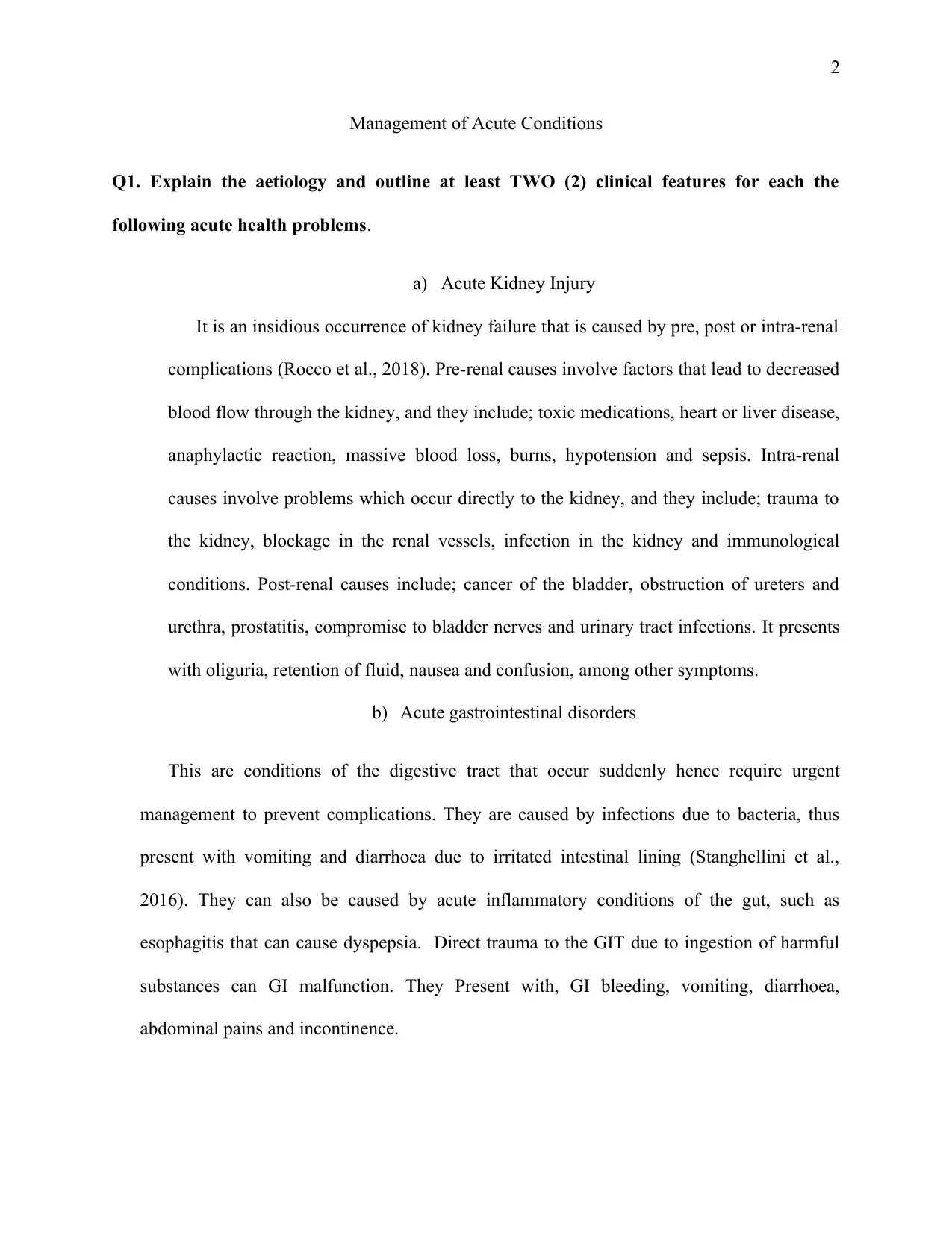
2
Management of Acute Conditions
Q1. Explain the aetiology and outline at least TWO (2) clinical features for each the
following acute health problems.
a) Acute Kidney Injury
It is an insidious occurrence of kidney failure that is caused by pre, post or intra-renal
complications (Rocco et al., 2018). Pre-renal causes involve factors that lead to decreased
blood flow through the kidney, and they include; toxic medications, heart or liver disease,
anaphylactic reaction, massive blood loss, burns, hypotension and sepsis. Intra-renal
causes involve problems which occur directly to the kidney, and they include; trauma to
the kidney, blockage in the renal vessels, infection in the kidney and immunological
conditions. Post-renal causes include; cancer of the bladder, obstruction of ureters and
urethra, prostatitis, compromise to bladder nerves and urinary tract infections. It presents
with oliguria, retention of fluid, nausea and confusion, among other symptoms.
b) Acute gastrointestinal disorders
This are conditions of the digestive tract that occur suddenly hence require urgent
management to prevent complications. They are caused by infections due to bacteria, thus
present with vomiting and diarrhoea due to irritated intestinal lining (Stanghellini et al.,
2016). They can also be caused by acute inflammatory conditions of the gut, such as
esophagitis that can cause dyspepsia. Direct trauma to the GIT due to ingestion of harmful
substances can GI malfunction. They Present with, GI bleeding, vomiting, diarrhoea,
abdominal pains and incontinence.
Management of Acute Conditions
Q1. Explain the aetiology and outline at least TWO (2) clinical features for each the
following acute health problems.
a) Acute Kidney Injury
It is an insidious occurrence of kidney failure that is caused by pre, post or intra-renal
complications (Rocco et al., 2018). Pre-renal causes involve factors that lead to decreased
blood flow through the kidney, and they include; toxic medications, heart or liver disease,
anaphylactic reaction, massive blood loss, burns, hypotension and sepsis. Intra-renal
causes involve problems which occur directly to the kidney, and they include; trauma to
the kidney, blockage in the renal vessels, infection in the kidney and immunological
conditions. Post-renal causes include; cancer of the bladder, obstruction of ureters and
urethra, prostatitis, compromise to bladder nerves and urinary tract infections. It presents
with oliguria, retention of fluid, nausea and confusion, among other symptoms.
b) Acute gastrointestinal disorders
This are conditions of the digestive tract that occur suddenly hence require urgent
management to prevent complications. They are caused by infections due to bacteria, thus
present with vomiting and diarrhoea due to irritated intestinal lining (Stanghellini et al.,
2016). They can also be caused by acute inflammatory conditions of the gut, such as
esophagitis that can cause dyspepsia. Direct trauma to the GIT due to ingestion of harmful
substances can GI malfunction. They Present with, GI bleeding, vomiting, diarrhoea,
abdominal pains and incontinence.
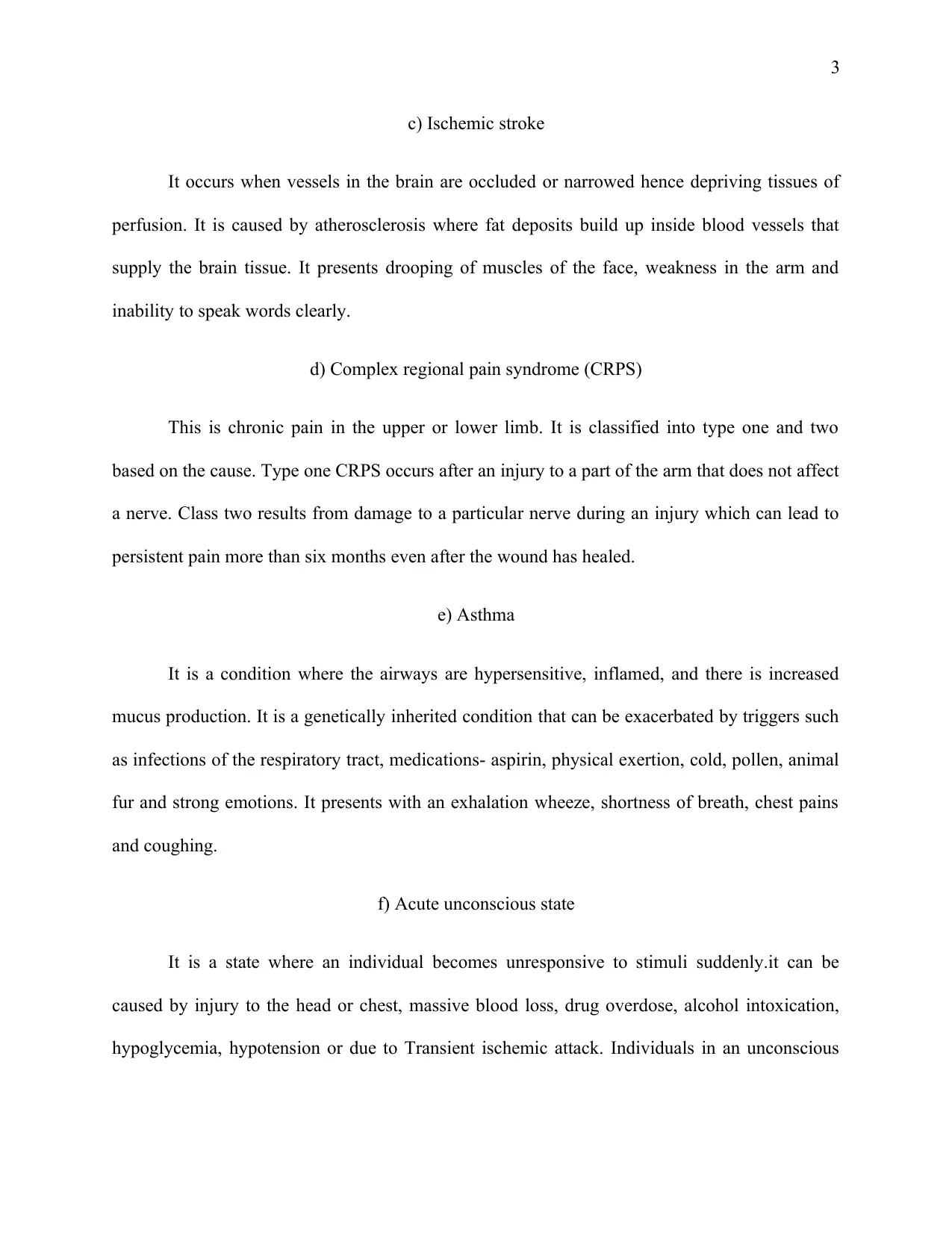
3
c) Ischemic stroke
It occurs when vessels in the brain are occluded or narrowed hence depriving tissues of
perfusion. It is caused by atherosclerosis where fat deposits build up inside blood vessels that
supply the brain tissue. It presents drooping of muscles of the face, weakness in the arm and
inability to speak words clearly.
d) Complex regional pain syndrome (CRPS)
This is chronic pain in the upper or lower limb. It is classified into type one and two
based on the cause. Type one CRPS occurs after an injury to a part of the arm that does not affect
a nerve. Class two results from damage to a particular nerve during an injury which can lead to
persistent pain more than six months even after the wound has healed.
e) Asthma
It is a condition where the airways are hypersensitive, inflamed, and there is increased
mucus production. It is a genetically inherited condition that can be exacerbated by triggers such
as infections of the respiratory tract, medications- aspirin, physical exertion, cold, pollen, animal
fur and strong emotions. It presents with an exhalation wheeze, shortness of breath, chest pains
and coughing.
f) Acute unconscious state
It is a state where an individual becomes unresponsive to stimuli suddenly.it can be
caused by injury to the head or chest, massive blood loss, drug overdose, alcohol intoxication,
hypoglycemia, hypotension or due to Transient ischemic attack. Individuals in an unconscious
c) Ischemic stroke
It occurs when vessels in the brain are occluded or narrowed hence depriving tissues of
perfusion. It is caused by atherosclerosis where fat deposits build up inside blood vessels that
supply the brain tissue. It presents drooping of muscles of the face, weakness in the arm and
inability to speak words clearly.
d) Complex regional pain syndrome (CRPS)
This is chronic pain in the upper or lower limb. It is classified into type one and two
based on the cause. Type one CRPS occurs after an injury to a part of the arm that does not affect
a nerve. Class two results from damage to a particular nerve during an injury which can lead to
persistent pain more than six months even after the wound has healed.
e) Asthma
It is a condition where the airways are hypersensitive, inflamed, and there is increased
mucus production. It is a genetically inherited condition that can be exacerbated by triggers such
as infections of the respiratory tract, medications- aspirin, physical exertion, cold, pollen, animal
fur and strong emotions. It presents with an exhalation wheeze, shortness of breath, chest pains
and coughing.
f) Acute unconscious state
It is a state where an individual becomes unresponsive to stimuli suddenly.it can be
caused by injury to the head or chest, massive blood loss, drug overdose, alcohol intoxication,
hypoglycemia, hypotension or due to Transient ischemic attack. Individuals in an unconscious
⊘ This is a preview!⊘
Do you want full access?
Subscribe today to unlock all pages.

Trusted by 1+ million students worldwide
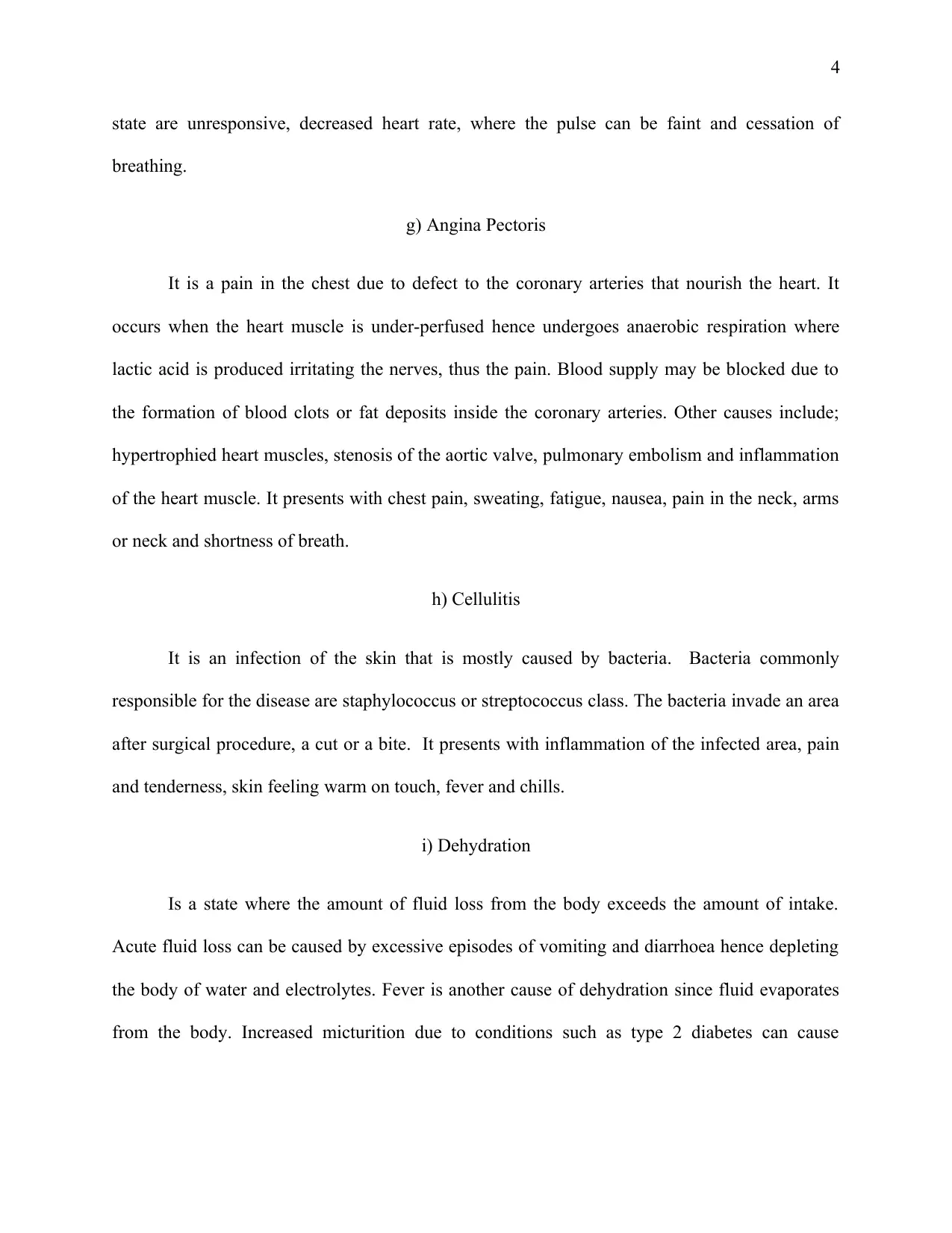
4
state are unresponsive, decreased heart rate, where the pulse can be faint and cessation of
breathing.
g) Angina Pectoris
It is a pain in the chest due to defect to the coronary arteries that nourish the heart. It
occurs when the heart muscle is under-perfused hence undergoes anaerobic respiration where
lactic acid is produced irritating the nerves, thus the pain. Blood supply may be blocked due to
the formation of blood clots or fat deposits inside the coronary arteries. Other causes include;
hypertrophied heart muscles, stenosis of the aortic valve, pulmonary embolism and inflammation
of the heart muscle. It presents with chest pain, sweating, fatigue, nausea, pain in the neck, arms
or neck and shortness of breath.
h) Cellulitis
It is an infection of the skin that is mostly caused by bacteria. Bacteria commonly
responsible for the disease are staphylococcus or streptococcus class. The bacteria invade an area
after surgical procedure, a cut or a bite. It presents with inflammation of the infected area, pain
and tenderness, skin feeling warm on touch, fever and chills.
i) Dehydration
Is a state where the amount of fluid loss from the body exceeds the amount of intake.
Acute fluid loss can be caused by excessive episodes of vomiting and diarrhoea hence depleting
the body of water and electrolytes. Fever is another cause of dehydration since fluid evaporates
from the body. Increased micturition due to conditions such as type 2 diabetes can cause
state are unresponsive, decreased heart rate, where the pulse can be faint and cessation of
breathing.
g) Angina Pectoris
It is a pain in the chest due to defect to the coronary arteries that nourish the heart. It
occurs when the heart muscle is under-perfused hence undergoes anaerobic respiration where
lactic acid is produced irritating the nerves, thus the pain. Blood supply may be blocked due to
the formation of blood clots or fat deposits inside the coronary arteries. Other causes include;
hypertrophied heart muscles, stenosis of the aortic valve, pulmonary embolism and inflammation
of the heart muscle. It presents with chest pain, sweating, fatigue, nausea, pain in the neck, arms
or neck and shortness of breath.
h) Cellulitis
It is an infection of the skin that is mostly caused by bacteria. Bacteria commonly
responsible for the disease are staphylococcus or streptococcus class. The bacteria invade an area
after surgical procedure, a cut or a bite. It presents with inflammation of the infected area, pain
and tenderness, skin feeling warm on touch, fever and chills.
i) Dehydration
Is a state where the amount of fluid loss from the body exceeds the amount of intake.
Acute fluid loss can be caused by excessive episodes of vomiting and diarrhoea hence depleting
the body of water and electrolytes. Fever is another cause of dehydration since fluid evaporates
from the body. Increased micturition due to conditions such as type 2 diabetes can cause
Paraphrase This Document
Need a fresh take? Get an instant paraphrase of this document with our AI Paraphraser
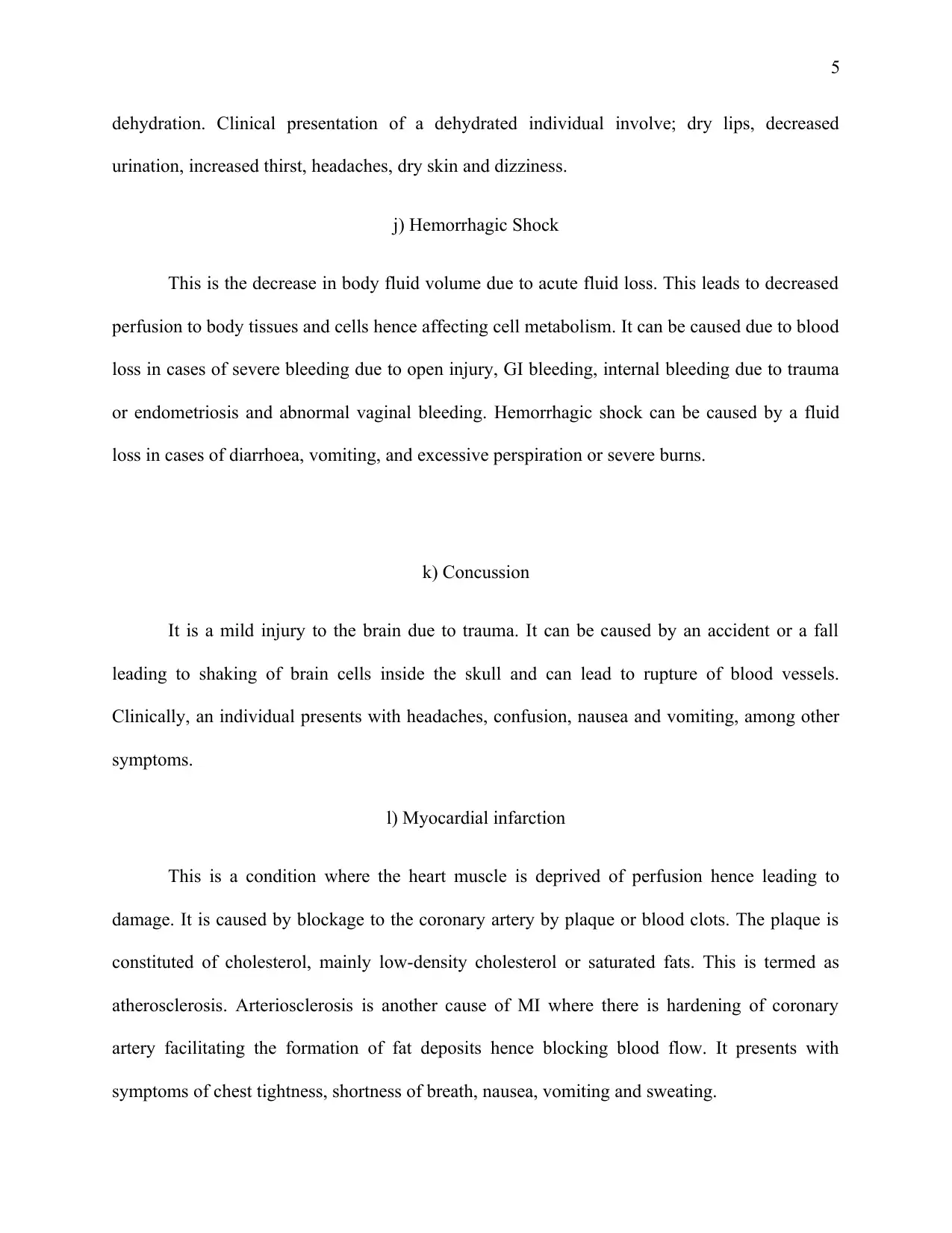
5
dehydration. Clinical presentation of a dehydrated individual involve; dry lips, decreased
urination, increased thirst, headaches, dry skin and dizziness.
j) Hemorrhagic Shock
This is the decrease in body fluid volume due to acute fluid loss. This leads to decreased
perfusion to body tissues and cells hence affecting cell metabolism. It can be caused due to blood
loss in cases of severe bleeding due to open injury, GI bleeding, internal bleeding due to trauma
or endometriosis and abnormal vaginal bleeding. Hemorrhagic shock can be caused by a fluid
loss in cases of diarrhoea, vomiting, and excessive perspiration or severe burns.
k) Concussion
It is a mild injury to the brain due to trauma. It can be caused by an accident or a fall
leading to shaking of brain cells inside the skull and can lead to rupture of blood vessels.
Clinically, an individual presents with headaches, confusion, nausea and vomiting, among other
symptoms.
l) Myocardial infarction
This is a condition where the heart muscle is deprived of perfusion hence leading to
damage. It is caused by blockage to the coronary artery by plaque or blood clots. The plaque is
constituted of cholesterol, mainly low-density cholesterol or saturated fats. This is termed as
atherosclerosis. Arteriosclerosis is another cause of MI where there is hardening of coronary
artery facilitating the formation of fat deposits hence blocking blood flow. It presents with
symptoms of chest tightness, shortness of breath, nausea, vomiting and sweating.
dehydration. Clinical presentation of a dehydrated individual involve; dry lips, decreased
urination, increased thirst, headaches, dry skin and dizziness.
j) Hemorrhagic Shock
This is the decrease in body fluid volume due to acute fluid loss. This leads to decreased
perfusion to body tissues and cells hence affecting cell metabolism. It can be caused due to blood
loss in cases of severe bleeding due to open injury, GI bleeding, internal bleeding due to trauma
or endometriosis and abnormal vaginal bleeding. Hemorrhagic shock can be caused by a fluid
loss in cases of diarrhoea, vomiting, and excessive perspiration or severe burns.
k) Concussion
It is a mild injury to the brain due to trauma. It can be caused by an accident or a fall
leading to shaking of brain cells inside the skull and can lead to rupture of blood vessels.
Clinically, an individual presents with headaches, confusion, nausea and vomiting, among other
symptoms.
l) Myocardial infarction
This is a condition where the heart muscle is deprived of perfusion hence leading to
damage. It is caused by blockage to the coronary artery by plaque or blood clots. The plaque is
constituted of cholesterol, mainly low-density cholesterol or saturated fats. This is termed as
atherosclerosis. Arteriosclerosis is another cause of MI where there is hardening of coronary
artery facilitating the formation of fat deposits hence blocking blood flow. It presents with
symptoms of chest tightness, shortness of breath, nausea, vomiting and sweating.
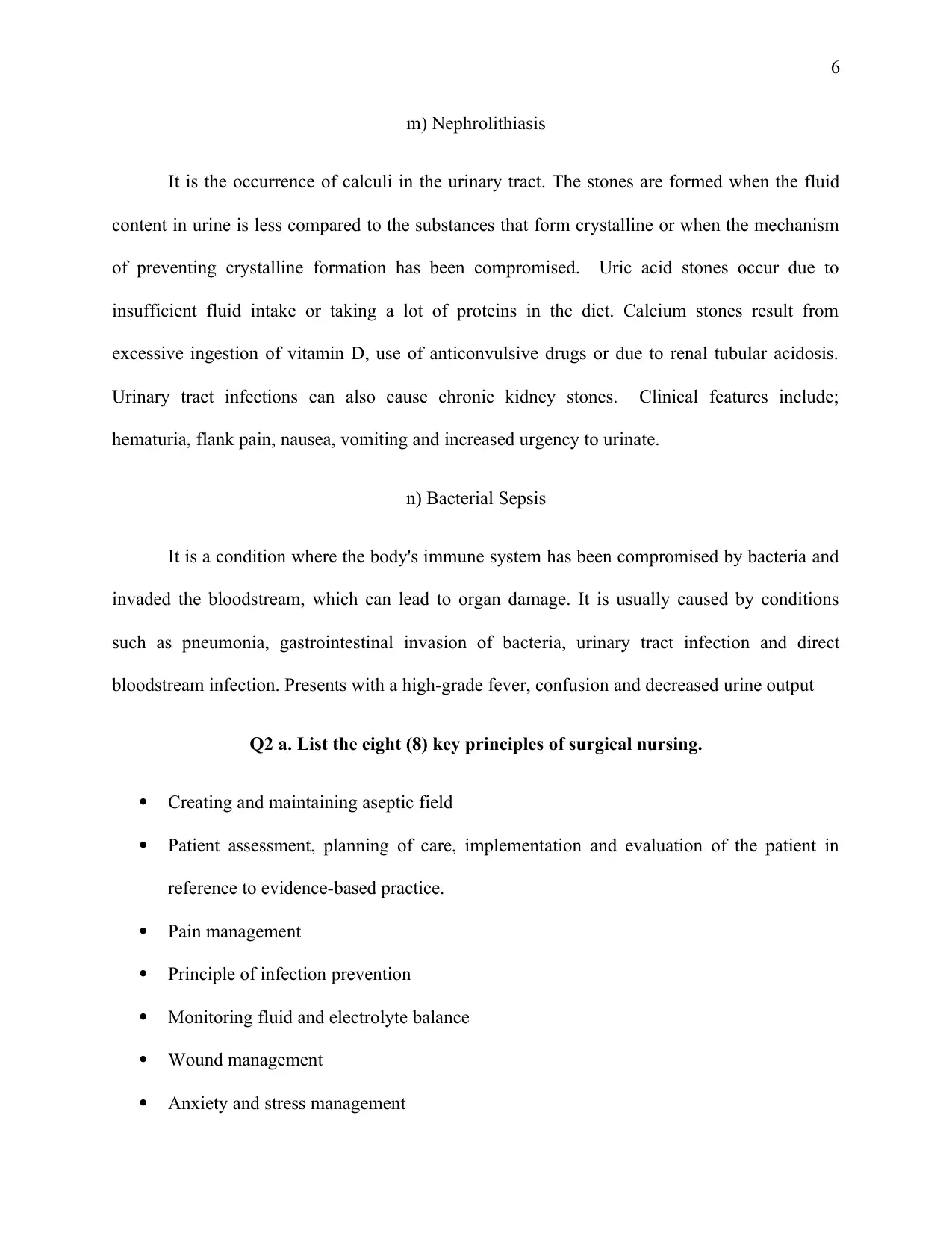
6
m) Nephrolithiasis
It is the occurrence of calculi in the urinary tract. The stones are formed when the fluid
content in urine is less compared to the substances that form crystalline or when the mechanism
of preventing crystalline formation has been compromised. Uric acid stones occur due to
insufficient fluid intake or taking a lot of proteins in the diet. Calcium stones result from
excessive ingestion of vitamin D, use of anticonvulsive drugs or due to renal tubular acidosis.
Urinary tract infections can also cause chronic kidney stones. Clinical features include;
hematuria, flank pain, nausea, vomiting and increased urgency to urinate.
n) Bacterial Sepsis
It is a condition where the body's immune system has been compromised by bacteria and
invaded the bloodstream, which can lead to organ damage. It is usually caused by conditions
such as pneumonia, gastrointestinal invasion of bacteria, urinary tract infection and direct
bloodstream infection. Presents with a high-grade fever, confusion and decreased urine output
Q2 a. List the eight (8) key principles of surgical nursing.
Creating and maintaining aseptic field
Patient assessment, planning of care, implementation and evaluation of the patient in
reference to evidence-based practice.
Pain management
Principle of infection prevention
Monitoring fluid and electrolyte balance
Wound management
Anxiety and stress management
m) Nephrolithiasis
It is the occurrence of calculi in the urinary tract. The stones are formed when the fluid
content in urine is less compared to the substances that form crystalline or when the mechanism
of preventing crystalline formation has been compromised. Uric acid stones occur due to
insufficient fluid intake or taking a lot of proteins in the diet. Calcium stones result from
excessive ingestion of vitamin D, use of anticonvulsive drugs or due to renal tubular acidosis.
Urinary tract infections can also cause chronic kidney stones. Clinical features include;
hematuria, flank pain, nausea, vomiting and increased urgency to urinate.
n) Bacterial Sepsis
It is a condition where the body's immune system has been compromised by bacteria and
invaded the bloodstream, which can lead to organ damage. It is usually caused by conditions
such as pneumonia, gastrointestinal invasion of bacteria, urinary tract infection and direct
bloodstream infection. Presents with a high-grade fever, confusion and decreased urine output
Q2 a. List the eight (8) key principles of surgical nursing.
Creating and maintaining aseptic field
Patient assessment, planning of care, implementation and evaluation of the patient in
reference to evidence-based practice.
Pain management
Principle of infection prevention
Monitoring fluid and electrolyte balance
Wound management
Anxiety and stress management
⊘ This is a preview!⊘
Do you want full access?
Subscribe today to unlock all pages.

Trusted by 1+ million students worldwide
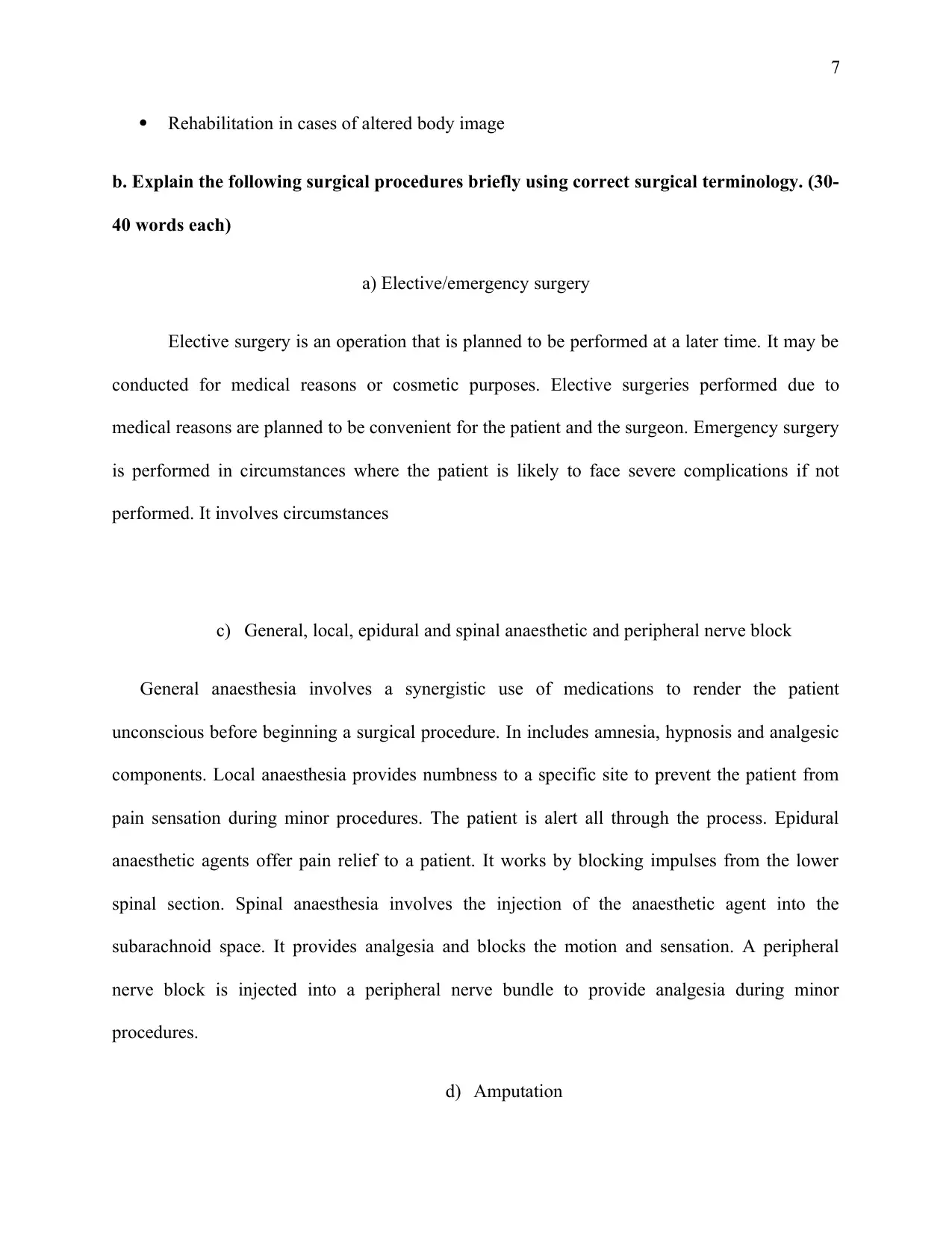
7
Rehabilitation in cases of altered body image
b. Explain the following surgical procedures briefly using correct surgical terminology. (30-
40 words each)
a) Elective/emergency surgery
Elective surgery is an operation that is planned to be performed at a later time. It may be
conducted for medical reasons or cosmetic purposes. Elective surgeries performed due to
medical reasons are planned to be convenient for the patient and the surgeon. Emergency surgery
is performed in circumstances where the patient is likely to face severe complications if not
performed. It involves circumstances
c) General, local, epidural and spinal anaesthetic and peripheral nerve block
General anaesthesia involves a synergistic use of medications to render the patient
unconscious before beginning a surgical procedure. In includes amnesia, hypnosis and analgesic
components. Local anaesthesia provides numbness to a specific site to prevent the patient from
pain sensation during minor procedures. The patient is alert all through the process. Epidural
anaesthetic agents offer pain relief to a patient. It works by blocking impulses from the lower
spinal section. Spinal anaesthesia involves the injection of the anaesthetic agent into the
subarachnoid space. It provides analgesia and blocks the motion and sensation. A peripheral
nerve block is injected into a peripheral nerve bundle to provide analgesia during minor
procedures.
d) Amputation
Rehabilitation in cases of altered body image
b. Explain the following surgical procedures briefly using correct surgical terminology. (30-
40 words each)
a) Elective/emergency surgery
Elective surgery is an operation that is planned to be performed at a later time. It may be
conducted for medical reasons or cosmetic purposes. Elective surgeries performed due to
medical reasons are planned to be convenient for the patient and the surgeon. Emergency surgery
is performed in circumstances where the patient is likely to face severe complications if not
performed. It involves circumstances
c) General, local, epidural and spinal anaesthetic and peripheral nerve block
General anaesthesia involves a synergistic use of medications to render the patient
unconscious before beginning a surgical procedure. In includes amnesia, hypnosis and analgesic
components. Local anaesthesia provides numbness to a specific site to prevent the patient from
pain sensation during minor procedures. The patient is alert all through the process. Epidural
anaesthetic agents offer pain relief to a patient. It works by blocking impulses from the lower
spinal section. Spinal anaesthesia involves the injection of the anaesthetic agent into the
subarachnoid space. It provides analgesia and blocks the motion and sensation. A peripheral
nerve block is injected into a peripheral nerve bundle to provide analgesia during minor
procedures.
d) Amputation
Paraphrase This Document
Need a fresh take? Get an instant paraphrase of this document with our AI Paraphraser
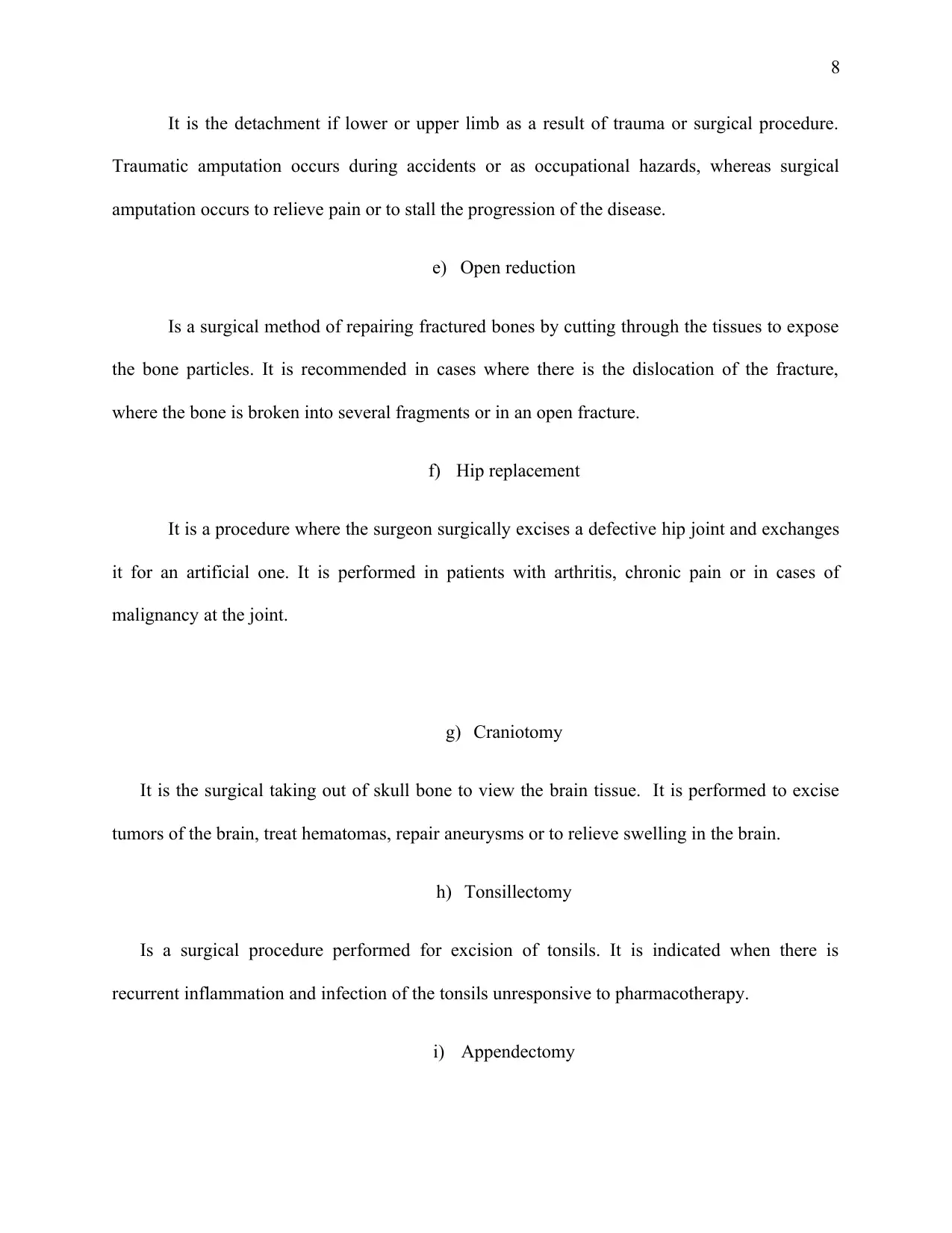
8
It is the detachment if lower or upper limb as a result of trauma or surgical procedure.
Traumatic amputation occurs during accidents or as occupational hazards, whereas surgical
amputation occurs to relieve pain or to stall the progression of the disease.
e) Open reduction
Is a surgical method of repairing fractured bones by cutting through the tissues to expose
the bone particles. It is recommended in cases where there is the dislocation of the fracture,
where the bone is broken into several fragments or in an open fracture.
f) Hip replacement
It is a procedure where the surgeon surgically excises a defective hip joint and exchanges
it for an artificial one. It is performed in patients with arthritis, chronic pain or in cases of
malignancy at the joint.
g) Craniotomy
It is the surgical taking out of skull bone to view the brain tissue. It is performed to excise
tumors of the brain, treat hematomas, repair aneurysms or to relieve swelling in the brain.
h) Tonsillectomy
Is a surgical procedure performed for excision of tonsils. It is indicated when there is
recurrent inflammation and infection of the tonsils unresponsive to pharmacotherapy.
i) Appendectomy
It is the detachment if lower or upper limb as a result of trauma or surgical procedure.
Traumatic amputation occurs during accidents or as occupational hazards, whereas surgical
amputation occurs to relieve pain or to stall the progression of the disease.
e) Open reduction
Is a surgical method of repairing fractured bones by cutting through the tissues to expose
the bone particles. It is recommended in cases where there is the dislocation of the fracture,
where the bone is broken into several fragments or in an open fracture.
f) Hip replacement
It is a procedure where the surgeon surgically excises a defective hip joint and exchanges
it for an artificial one. It is performed in patients with arthritis, chronic pain or in cases of
malignancy at the joint.
g) Craniotomy
It is the surgical taking out of skull bone to view the brain tissue. It is performed to excise
tumors of the brain, treat hematomas, repair aneurysms or to relieve swelling in the brain.
h) Tonsillectomy
Is a surgical procedure performed for excision of tonsils. It is indicated when there is
recurrent inflammation and infection of the tonsils unresponsive to pharmacotherapy.
i) Appendectomy
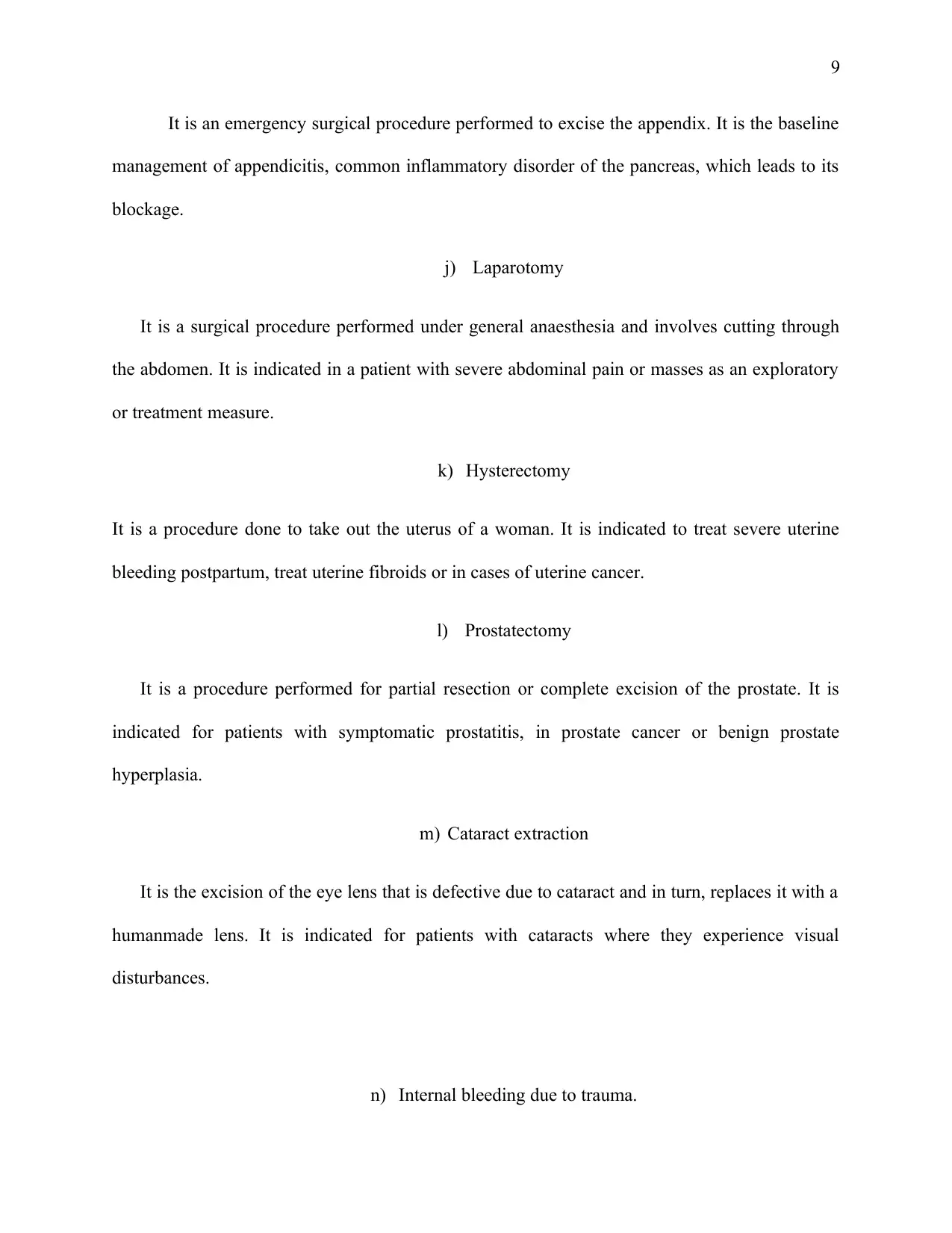
9
It is an emergency surgical procedure performed to excise the appendix. It is the baseline
management of appendicitis, common inflammatory disorder of the pancreas, which leads to its
blockage.
j) Laparotomy
It is a surgical procedure performed under general anaesthesia and involves cutting through
the abdomen. It is indicated in a patient with severe abdominal pain or masses as an exploratory
or treatment measure.
k) Hysterectomy
It is a procedure done to take out the uterus of a woman. It is indicated to treat severe uterine
bleeding postpartum, treat uterine fibroids or in cases of uterine cancer.
l) Prostatectomy
It is a procedure performed for partial resection or complete excision of the prostate. It is
indicated for patients with symptomatic prostatitis, in prostate cancer or benign prostate
hyperplasia.
m) Cataract extraction
It is the excision of the eye lens that is defective due to cataract and in turn, replaces it with a
humanmade lens. It is indicated for patients with cataracts where they experience visual
disturbances.
n) Internal bleeding due to trauma.
It is an emergency surgical procedure performed to excise the appendix. It is the baseline
management of appendicitis, common inflammatory disorder of the pancreas, which leads to its
blockage.
j) Laparotomy
It is a surgical procedure performed under general anaesthesia and involves cutting through
the abdomen. It is indicated in a patient with severe abdominal pain or masses as an exploratory
or treatment measure.
k) Hysterectomy
It is a procedure done to take out the uterus of a woman. It is indicated to treat severe uterine
bleeding postpartum, treat uterine fibroids or in cases of uterine cancer.
l) Prostatectomy
It is a procedure performed for partial resection or complete excision of the prostate. It is
indicated for patients with symptomatic prostatitis, in prostate cancer or benign prostate
hyperplasia.
m) Cataract extraction
It is the excision of the eye lens that is defective due to cataract and in turn, replaces it with a
humanmade lens. It is indicated for patients with cataracts where they experience visual
disturbances.
n) Internal bleeding due to trauma.
⊘ This is a preview!⊘
Do you want full access?
Subscribe today to unlock all pages.

Trusted by 1+ million students worldwide

10
This refers to haemorrhage into internal organs that occur due to rupture of an inner
blood vessel after trauma. It is a severe medical condition and can result in severe complications.
Q3 Too Wadadi is a 16-year-old Maori boy from New Zealand who was rushed to the
Emergency Department this morning with testicular torsion. After initial blood work, he
was shifted to the operating room. The surgical procedure completed at noon and the
patient was moved to the post-operative ICU.
What is the significance of holistic nursing car?
Holistic nursing care is the process of taking care of a patient by considering the patient
as a whole. It involves caring for the physical, psychological, emotional, mental and social aspect
of a patient. It also encompasses the cultural beliefs and religious concerns of the patient. It
enables in the creation of healthy relationships between the patient and nurse, leading to
improved quality of care. It creates a variety of treatment options for the patient apart from the
routine medications. It enables the nurse to approach the patient individually and provide an
individualized plan of care. It puts into consideration the patients' age, race, psychological state
and mental condition. Understanding patient state of well-being improves confidentiality hence
promoting care. Holistic care enables the nurse to identify underlying issues of the patient,
including feeding problems, stress and domestic abuse on top of the presenting complaints.
Comprehensive care of patients is an evidence-based practice that promotes healing and quality
of life.
Outline the application of holistic nursing in the treatment of Too Too Wadadi considering
his age, gender and specific culture.
This refers to haemorrhage into internal organs that occur due to rupture of an inner
blood vessel after trauma. It is a severe medical condition and can result in severe complications.
Q3 Too Wadadi is a 16-year-old Maori boy from New Zealand who was rushed to the
Emergency Department this morning with testicular torsion. After initial blood work, he
was shifted to the operating room. The surgical procedure completed at noon and the
patient was moved to the post-operative ICU.
What is the significance of holistic nursing car?
Holistic nursing care is the process of taking care of a patient by considering the patient
as a whole. It involves caring for the physical, psychological, emotional, mental and social aspect
of a patient. It also encompasses the cultural beliefs and religious concerns of the patient. It
enables in the creation of healthy relationships between the patient and nurse, leading to
improved quality of care. It creates a variety of treatment options for the patient apart from the
routine medications. It enables the nurse to approach the patient individually and provide an
individualized plan of care. It puts into consideration the patients' age, race, psychological state
and mental condition. Understanding patient state of well-being improves confidentiality hence
promoting care. Holistic care enables the nurse to identify underlying issues of the patient,
including feeding problems, stress and domestic abuse on top of the presenting complaints.
Comprehensive care of patients is an evidence-based practice that promotes healing and quality
of life.
Outline the application of holistic nursing in the treatment of Too Too Wadadi considering
his age, gender and specific culture.
Paraphrase This Document
Need a fresh take? Get an instant paraphrase of this document with our AI Paraphraser
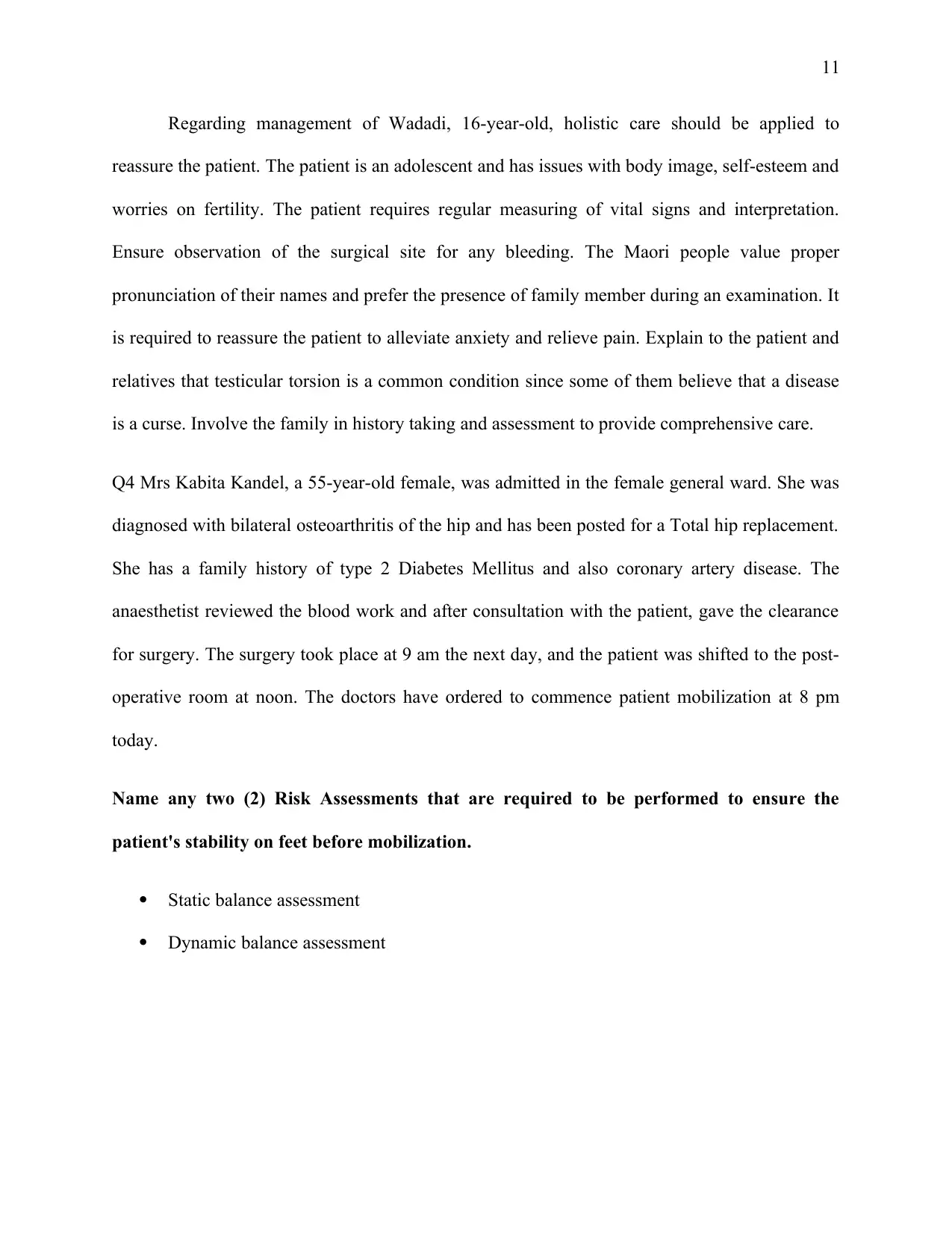
11
Regarding management of Wadadi, 16-year-old, holistic care should be applied to
reassure the patient. The patient is an adolescent and has issues with body image, self-esteem and
worries on fertility. The patient requires regular measuring of vital signs and interpretation.
Ensure observation of the surgical site for any bleeding. The Maori people value proper
pronunciation of their names and prefer the presence of family member during an examination. It
is required to reassure the patient to alleviate anxiety and relieve pain. Explain to the patient and
relatives that testicular torsion is a common condition since some of them believe that a disease
is a curse. Involve the family in history taking and assessment to provide comprehensive care.
Q4 Mrs Kabita Kandel, a 55-year-old female, was admitted in the female general ward. She was
diagnosed with bilateral osteoarthritis of the hip and has been posted for a Total hip replacement.
She has a family history of type 2 Diabetes Mellitus and also coronary artery disease. The
anaesthetist reviewed the blood work and after consultation with the patient, gave the clearance
for surgery. The surgery took place at 9 am the next day, and the patient was shifted to the post-
operative room at noon. The doctors have ordered to commence patient mobilization at 8 pm
today.
Name any two (2) Risk Assessments that are required to be performed to ensure the
patient's stability on feet before mobilization.
Static balance assessment
Dynamic balance assessment
Regarding management of Wadadi, 16-year-old, holistic care should be applied to
reassure the patient. The patient is an adolescent and has issues with body image, self-esteem and
worries on fertility. The patient requires regular measuring of vital signs and interpretation.
Ensure observation of the surgical site for any bleeding. The Maori people value proper
pronunciation of their names and prefer the presence of family member during an examination. It
is required to reassure the patient to alleviate anxiety and relieve pain. Explain to the patient and
relatives that testicular torsion is a common condition since some of them believe that a disease
is a curse. Involve the family in history taking and assessment to provide comprehensive care.
Q4 Mrs Kabita Kandel, a 55-year-old female, was admitted in the female general ward. She was
diagnosed with bilateral osteoarthritis of the hip and has been posted for a Total hip replacement.
She has a family history of type 2 Diabetes Mellitus and also coronary artery disease. The
anaesthetist reviewed the blood work and after consultation with the patient, gave the clearance
for surgery. The surgery took place at 9 am the next day, and the patient was shifted to the post-
operative room at noon. The doctors have ordered to commence patient mobilization at 8 pm
today.
Name any two (2) Risk Assessments that are required to be performed to ensure the
patient's stability on feet before mobilization.
Static balance assessment
Dynamic balance assessment
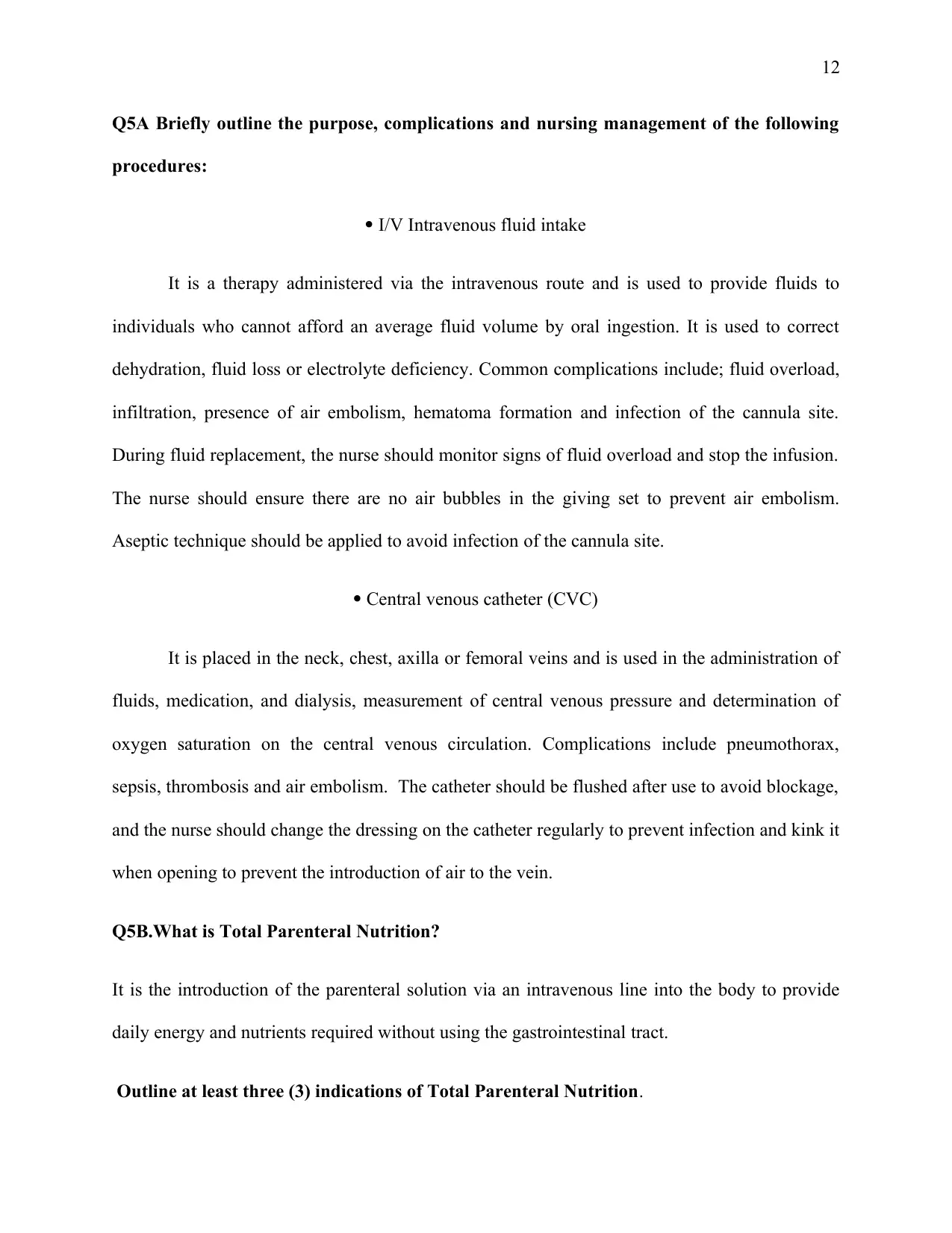
12
Q5A Briefly outline the purpose, complications and nursing management of the following
procedures:
I/V Intravenous fluid intake
It is a therapy administered via the intravenous route and is used to provide fluids to
individuals who cannot afford an average fluid volume by oral ingestion. It is used to correct
dehydration, fluid loss or electrolyte deficiency. Common complications include; fluid overload,
infiltration, presence of air embolism, hematoma formation and infection of the cannula site.
During fluid replacement, the nurse should monitor signs of fluid overload and stop the infusion.
The nurse should ensure there are no air bubbles in the giving set to prevent air embolism.
Aseptic technique should be applied to avoid infection of the cannula site.
Central venous catheter (CVC)
It is placed in the neck, chest, axilla or femoral veins and is used in the administration of
fluids, medication, and dialysis, measurement of central venous pressure and determination of
oxygen saturation on the central venous circulation. Complications include pneumothorax,
sepsis, thrombosis and air embolism. The catheter should be flushed after use to avoid blockage,
and the nurse should change the dressing on the catheter regularly to prevent infection and kink it
when opening to prevent the introduction of air to the vein.
Q5B.What is Total Parenteral Nutrition?
It is the introduction of the parenteral solution via an intravenous line into the body to provide
daily energy and nutrients required without using the gastrointestinal tract.
Outline at least three (3) indications of Total Parenteral Nutrition.
Q5A Briefly outline the purpose, complications and nursing management of the following
procedures:
I/V Intravenous fluid intake
It is a therapy administered via the intravenous route and is used to provide fluids to
individuals who cannot afford an average fluid volume by oral ingestion. It is used to correct
dehydration, fluid loss or electrolyte deficiency. Common complications include; fluid overload,
infiltration, presence of air embolism, hematoma formation and infection of the cannula site.
During fluid replacement, the nurse should monitor signs of fluid overload and stop the infusion.
The nurse should ensure there are no air bubbles in the giving set to prevent air embolism.
Aseptic technique should be applied to avoid infection of the cannula site.
Central venous catheter (CVC)
It is placed in the neck, chest, axilla or femoral veins and is used in the administration of
fluids, medication, and dialysis, measurement of central venous pressure and determination of
oxygen saturation on the central venous circulation. Complications include pneumothorax,
sepsis, thrombosis and air embolism. The catheter should be flushed after use to avoid blockage,
and the nurse should change the dressing on the catheter regularly to prevent infection and kink it
when opening to prevent the introduction of air to the vein.
Q5B.What is Total Parenteral Nutrition?
It is the introduction of the parenteral solution via an intravenous line into the body to provide
daily energy and nutrients required without using the gastrointestinal tract.
Outline at least three (3) indications of Total Parenteral Nutrition.
⊘ This is a preview!⊘
Do you want full access?
Subscribe today to unlock all pages.

Trusted by 1+ million students worldwide
1 out of 36
Related Documents
Your All-in-One AI-Powered Toolkit for Academic Success.
+13062052269
info@desklib.com
Available 24*7 on WhatsApp / Email
![[object Object]](/_next/static/media/star-bottom.7253800d.svg)
Unlock your academic potential
Copyright © 2020–2025 A2Z Services. All Rights Reserved. Developed and managed by ZUCOL.





